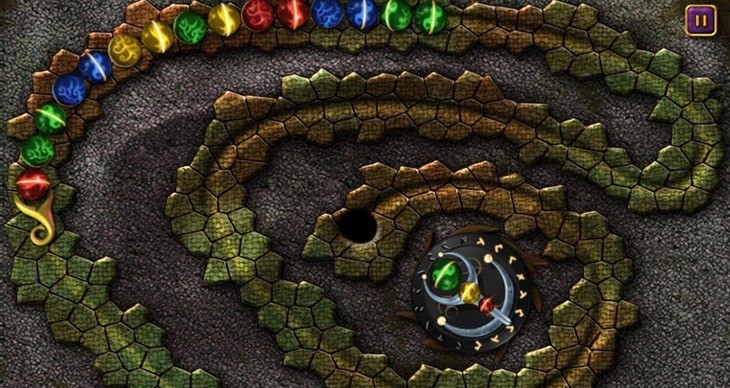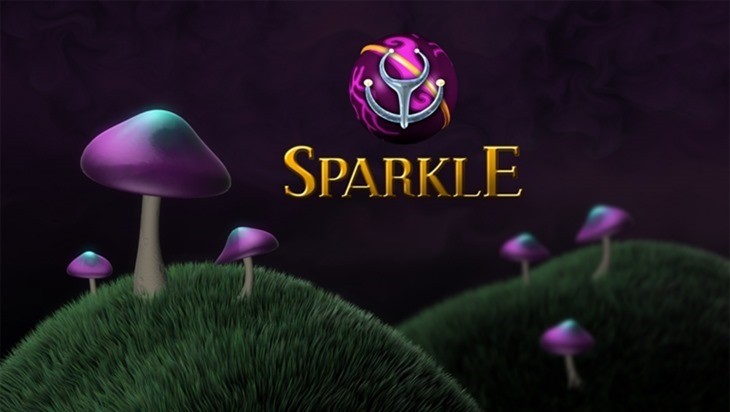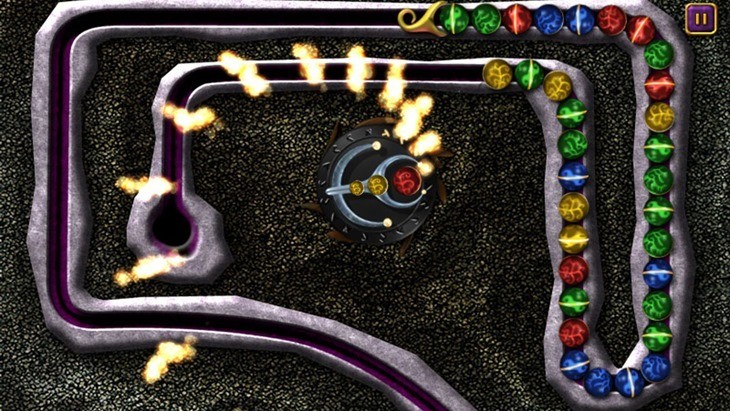The PlayStation Vita software library has been gradually building a catalogue of high-budget, first-party titles with all sorts of production values. But sometimes you just want to use that high-res touch screen for some simple mobile gaming without all the bells and whistles. Enter the marble shooter Sparkle from developer 10tons. This game provides an eminently familiar experience for most, but it’s a good way to satisfy the craving for some mindless, small-serving gaming at a low price.
If you’ve ever played Zuma (or its inspiration, Puzz Loop), you’re going to feel immediately comfortable with Sparkle. As with the former, the core gameplay in this title consists of a string of coloured orbs flowing in a single line along a set path, which weaves its way to a hole at the end. The player’s goal is to prevent the orbs from reaching the hole. This is accomplished by utilizing a rotating mechanism to fire additional coloured orbs at the string, the object being to create a concurrent line of least three orbs of the same colour — at which time they disappear and the string becomes shorter. The Vita’s analogue sticks and buttons can be used to play, but the touch screen is the more immediate and accurate interface for this one.
To accompany the tried-and-true core mechanic, Sparkle includes somewhat of a narrative. There is a darkness rising, and the only thing that can stop it is in Crowberry Woods. You play the role of someone who is “caught in the middle of all this,” and are tasked with battling back this darkness.
Hop into the Quest mode to embark on your journey, but don’t expect the story to flesh out. Instead, you’ll immediately get to work, firing coloured orbs to eliminate the encroaching string. The first thing you’re likely to notice — aside from the pleasing visuals and smooth animations — is the excellent musical score courtesy of Jonathan Geer, which sounds like it would be right at home in a Tim Burton film. There aren’t very many songs, though, so even this fantastic accompaniment eventually becomes repetitive. There are also some jarring changes in music if the string of orbs nears the exit. Situations can change very quickly in Sparkle, so it can get annoying when the musical score keeps resetting itself in response. This is certainly a minimal gripe, as Sparkle plays perfectly with the sound completely off — no audio cues are necessary to enjoy it to the fullest.
Sparkle is very similar to the aforementioned Zuma — almost alarmingly so. But it makes some adjustments to expand on the core gameplay. When certain conditions are met, power-up bubbles appear somewhere on the field that activate when hit with an orb. They can have major implications, such as eliminating all orbs of a particular colour, or providing you with a single-shot beam that can eliminate any orbs in its path. As these power-ups do not appear directly in the path of the approaching orbs, reaching them can be a frantic scramble when you’re in trouble.
With the completion of each stage in Quest mode, you’ll cover ground across an over world map, reaching an occasional “boss” stage that typically includes two lanes for orb strings — a much more difficult endeavour than the single-lane stages. These stages offer one of many Amulets as an award, each of which carries a unique passive advantage. For instance, the Amulet of Swift allows your orbs to shoot twice as fast, while the Amulet of Small shrinks the approaching orbs and slows them down. You can only employ one Amulet at a time, so choosing the proper Amulet for a difficult stage creates a strategic element. Unfortunately, in this mode, there isn’t a way to see what level is next in line until you begin playing it, making it impossible to plan ahead. You’ll have to try and fail before having an opportunity to pick a new Amulet.
That’s not much of a problem for a while, though. Quest mode is almost completely devoid of challenge for the first couple hours of gameplay. I was nearly three hours into my play through before I finally failed a stage for the first time, and this entire mode will typically take less than five hours to complete. Still, when it gets hard, it gets really hard, introducing additional colours and increasing the speed of the orb strings. There is one stage in particular, Basis of Dreamscape, which includes three lanes of orb strings, providing a ridiculous jump in difficulty when it arrives.
Unique to the Quest mode is the presence of limited lives, and it feels rather old-fashioned in implementation. Each of the “boss” stages acts as a checkpoint — if you fail on a particular stage enough times to run out of lives, you’re sent back to the checkpoint with a reserve of three lives. With a sudden jump in difficulty among the last handful of stages, it seems needlessly frustrating to be required to replay several stages just to reach the one you’re having trouble with again. Plugging away would be less of a chore if you were allowed to stick to the difficult stages when you reach them.
The 100 stages of Quest mode become very repetitive after a while, mostly because there are only 26 unique stages that repeat throughout (many of them being very similar to each other already). Thankfully, there are two other modes that are better for some quick pick-up-and-play moments. One is the Challenge mode, where you pick any stage on any skill level and play a single round. The game tracks your progress, and trying to complete every stage on every skill level can be pretty addictive.
Even if you finish all of the Challenge mode stages, you’re still left with the Survival mode, and it might be the best one. Pick an Amulet and an associated stage and you begin on the lowest skill level. As you hit milestones, the difficulty rises, continuing indefinitely until you fail. As with the other modes, progress is tracked — returning to each stage to try to beat my record felt like the most fulfilling Sparkle experience. There are no leader boards, though, somewhat limiting your impetus to return. Participating in a scoring race against members of your PSN Friends List could have been a fun endeavour.
Sparkle isn’t blazing any trails or breaking new ground. It does, however, serve a particular purpose admirably well — bringing the simple-yet-addictive marble-shooter genre to the PlayStation Vita for cheaper than most titles ($5.99 on the PSN store). If taking a Zuma clone on the go with some PSN trophies in tow sounds like an attractive proposition to you, then you’re likely to find Sparkle to be worth the purchase price.
Last Updated: December 24, 2013
| Sparkle | |
|
Sparkle is an admirable choice for Vita owners who are fans of marble shooting. It’s nothing new, but it’s a cheaply priced game that’s liable to earn hours of your time.
|
|
|---|---|
| Sparkle was reviewed on PS Vita | |
|
72 /
100
| |

























VampyricSquirrel Monk
January 3, 2014 at 16:41
Totally missed this review… sorry Matt.
Looks like a total Zuma/Puzz Loop clone, of which there are many. But most of them are addictive and can waste hours of your life, and on something like a Vita, it must be torturous to your social life… but handy when shopping with the missus lmao.
If I had a Vita, I’d probably get this, just for the addictive time killing properties of it.